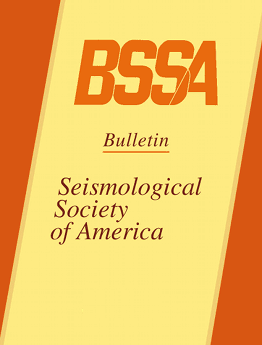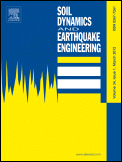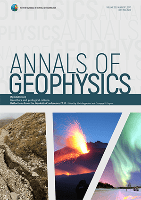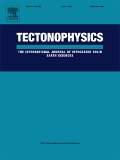
BULLETIN OF THE SEISMOLOGICAL SOCIETY OF AMERICA
Scope & Guideline
Delivering cutting-edge insights into seismic phenomena.
Introduction
Aims and Scopes
- Seismic Source Characterization:
Research on the characteristics of seismic sources including fault mechanics, rupture processes, and the relationship between seismicity and geological structures. - Ground-Motion Modeling:
Development and refinement of ground-motion prediction equations and models, particularly in relation to different geological settings and earthquake magnitudes. - Seismic Hazard Assessment:
Studies aimed at evaluating and predicting seismic hazards, including probabilistic seismic hazard assessments that incorporate site-specific conditions. - Induced Seismicity:
Exploration of human-induced seismic events, particularly related to activities such as mining, reservoir-induced seismicity, and hydraulic fracturing. - Advanced Seismic Monitoring Techniques:
Utilization of cutting-edge technologies, such as machine learning and distributed acoustic sensing, to enhance seismic monitoring and data analysis. - Paleoseismology and Earthquake Recurrence:
Investigation of historical earthquake records and geological evidence to understand seismic recurrence intervals and the long-term behavior of fault systems. - Interdisciplinary Approaches:
Integration of geophysical, geological, and engineering perspectives to address complex seismic issues and improve earthquake preparedness.
Trending and Emerging
- Machine Learning Applications in Seismology:
There is a significant trend towards incorporating machine learning techniques for various applications, including seismic event detection, ground-motion prediction, and data processing. - Real-Time Seismic Monitoring and Early Warning:
An increase in research focused on real-time monitoring systems and early warning applications, leveraging new technologies for faster and more accurate assessments of seismic hazards. - Induced Seismicity Studies:
Growing interest in understanding the mechanisms and implications of induced seismicity, particularly related to hydraulic fracturing and other anthropogenic activities. - Complex Seismic Wave Propagation Models:
Advancements in modeling seismic wave propagation in complex geological settings, reflecting a trend towards more sophisticated simulations that consider various physical parameters. - Interdisciplinary Research:
Emerging collaborations across geophysics, engineering, and environmental sciences to tackle multifaceted seismic challenges, indicating a shift towards holistic approaches in seismology. - Paleoseismic Research Enhancements:
Innovations in paleoseismic research methodologies that utilize advanced dating techniques and high-resolution imaging to better understand historical seismic events.
Declining or Waning
- Traditional Seismic Hazard Models:
There seems to be a decline in the focus on conventional seismic hazard models, as newer, more dynamic approaches incorporating real-time data and machine learning gain prominence. - Basic Seismological Measurements:
The emphasis on basic seismological measurements, such as magnitude calculations without considering contextual factors, appears to be waning in favor of more sophisticated analytical techniques. - Single-Event Analysis:
Research centered on single seismic events is becoming less prevalent, as there is a growing trend towards understanding seismic sequences and their interrelatedness. - Static Stress Models:
The application of static stress models in predicting earthquake occurrences is being overshadowed by dynamic models that account for time-dependent factors. - Conventional Earthquake Early Warning Systems:
Interest in traditional earthquake early warning systems seems to be declining, with a shift towards more comprehensive and technologically advanced systems that integrate a variety of data sources.
Similar Journals

SOIL DYNAMICS AND EARTHQUAKE ENGINEERING
Bridging Disciplines for a Safer, More Resilient FutureSOIL DYNAMICS AND EARTHQUAKE ENGINEERING is a premier academic journal published by ELSEVIER SCI LTD, focusing on the intersection of civil and structural engineering, geotechnical engineering, and soil science. Since its inception in 1986, the journal has established itself as a critical resource for advancing knowledge in these fields over nearly four decades, with a remarkable Q1 ranking in 2023 across multiple categories, including Civil and Structural Engineering, Geotechnical Engineering, and Soil Science. The journal’s impactful research, reflected in its high Scopus ranks, serves as a vital reference for both professionals and academics dedicated to understanding soil dynamics and mitigating earthquake hazards. Although it currently does not offer open access, the journal's rigorous peer-review process ensures that published articles provide substantial contributions to the understanding of soil behavior under seismic conditions. Whether you are a researcher, a practitioner, or a student, SOIL DYNAMICS AND EARTHQUAKE ENGINEERING offers essential insights and innovative methodologies pivotal for advancing your work in soil dynamics and earthquake engineering.

Quaderni di Geofisica
Bridging Theory and Practice in GeophysicsQuaderni di Geofisica is a distinguished academic journal published by the IST NAZIONALE GEOFISICA & VULCANOLOGIA-INGV in Italy, focusing on pivotal areas within the fields of geophysics, geology, and computer applications in Earth sciences. Since its inception, this journal has served as a vital platform for the dissemination of innovative research and methodologies, advancing our understanding of geophysical phenomena and their implications. The journal spans various converged years from 2007 to 2019 and 2021 to 2024, allowing for a comprehensive examination of contemporary developments in the field. Despite being categorized in Q3 and Q4 quartiles by Scopus, it plays a critical role in bridging the gap between theory and practice for researchers, professionals, and students alike. The journal's commitment to fostering scholarly communication is underscored by its strategic focus on multidisciplinary studies, making it an essential resource for those engaged in Earth sciences research. Readers can access the journal's content through institutional libraries or by direct request, ensuring a broad reach and ongoing contribution to the global scientific community.

CHINESE JOURNAL OF GEOPHYSICS-CHINESE EDITION
Fostering Excellence in Geophysical ResearchCHINESE JOURNAL OF GEOPHYSICS-CHINESE EDITION, published by SCIENCE PRESS, stands as a prominent platform for the dissemination of cutting-edge research in the fields of Geophysics and Geochemistry. Since its inception in 1979, this esteemed journal has successfully converged a wealth of knowledge, boasting a substantial impact factor and a recognized standing within the academic community, evidenced by its Q2 categorization in both Geochemistry and Petrology and Geophysics as of 2023. Researchers, professionals, and students looking to stay abreast of the latest advancements in solid-earth sciences will find the journal's comprehensive articles and studies invaluable. Based in Beijing, China, the journal emphasizes a broad scope, encompassing various aspects of geophysical research and methodologies. Although it does not currently offer open access options, its commitment to quality research makes it a crucial resource for the scientific community.

Geodynamics & Tectonophysics
Advancing Insights into Earth's Dynamic ProcessesGeodynamics & Tectonophysics, published by the esteemed Russian Academy of Sciences, Siberian Branch, Inst Earths Crust, is a pivotal open-access journal that has been contributing to the scientific discourse on Earth's dynamic processes since 2010. With an ISSN of 2078-502X, this journal serves as a vital platform for researchers and professionals interested in the fields of Earth-Surface Processes, Economic Geology, Geology, and Geophysics, holding a Q3 ranking in each of these categories as of 2023. The journal is based in Irkutsk, Russia, and encompasses a broad spectrum of topics, fostering interdisciplinary collaboration and innovation. Researchers can access cutting-edge studies and insights, engaging with a community committed to advancing our understanding of geodynamics and tectonic phenomena. With a sustained commitment to quality and accessibility, Geodynamics & Tectonophysics plays a critical role in addressing pressing geological concerns and advancing global geological research.

Earthquake Engineering and Engineering Vibration
Bridging research and application in earthquake engineering.Earthquake Engineering and Engineering Vibration, published by Springer, is a leading international journal dedicated to the field of earthquake engineering, structural dynamics, and the associated vibrational research integral to understanding and mitigating seismic risks. With its print ISSN 1671-3664 and E-ISSN 1993-503X, the journal operates from its headquarters in New York, USA. The journal has achieved a commendable Q2 category ranking across multiple engineering disciplines, reflecting its importance to the building and construction, civil and structural engineering, geophysics, geotechnical engineering, and mechanical engineering fields. The journal serves as a vital platform for researchers, practitioners, and students to disseminate their findings, share innovative methodologies, and contribute to advancements in earthquake resilience and engineering practices. Earthquake Engineering and Engineering Vibration is committed to fostering open dialogue and collaboration within the global research community, ensuring that its contributions are both impactful and relevant to contemporary challenges in engineering and environmental safety.

Seismic Instruments
Empowering seismic research through cutting-edge instrumentation.Seismic Instruments is a prestigious academic journal dedicated to advancing the field of geophysical instrumentation and its applications in seismic studies. Published by PLEIADES PUBLISHING INC, this journal serves as a crucial resource for researchers, professionals, and students interested in the development, evaluation, and deployment of seismic instrumentation technologies. Although it does not currently offer open access, it provides a comprehensive platform for high-quality research articles, reviews, and technical notes that explore the latest innovations and findings in seismic studies. With an ISSN of 0747-9239 and an E-ISSN of 1934-7871, Seismic Instruments aims to foster collaboration and knowledge exchange among the global academic community, emphasizing the importance of instrumentation in understanding seismic activity and its implications for engineering, environmental science, and hazard mitigation.

Geofisica Internacional
Fostering Global Dialogue on Earth’s Energy ResourcesGeofisica Internacional, an esteemed academic journal published by the Instituto de Geofísica at UNAM, Mexico's prestigious National Autonomous University, has been a pivotal platform for advancing the field of geophysics and energy studies since its inception in 1975. This Open Access journal aims to disseminate high-quality research findings, making significant contributions to our understanding of Earth's processes and energy resources. With a current impact factor that situates it in the Q3 category for both Energy (miscellaneous) and Geophysics, it provides a continuous dialogue for researchers, professionals, and students interested in the intersection of these critical areas. Based in Mexico City and publishing articles that span various geophysical disciplines, Geofisica Internacional is indispensable for anyone seeking to stay at the forefront of environmental and energy research.

Ingegneria Sismica
Transforming understanding of seismic risk mitigation strategies.Ingegneria Sismica, a premier journal published by PATRON EDITORE S R L, serves as an essential platform for the dissemination of research in the fields of building and construction, geotechnical engineering, and safety risk management. With a focus on earthquake engineering and structural safety, the journal has established itself as a prominent source of knowledge since its inception in 2010. The journal holds an impressive Q2 classification in multiple categories, including Building and Construction and Geotechnical Engineering, reflecting its significant impact within these disciplines. Despite its Italian roots, it appeals to an international audience of researchers, professionals, and students dedicated to advancing the understanding of seismic resilience and risk mitigation strategies. Although open access is not currently available, the potential for knowledge sharing and innovative methodologies presented in the articles continues to attract a robust readership. With its commitment to excellence and relevance, Ingegneria Sismica is poised to shape future discourse in engineering practices aimed at enhancing safety, reliability, and quality within seismic zones.

ANNALS OF GEOPHYSICS
Championing Open Access to Transform Geophysical ResearchANNALS OF GEOPHYSICS is a prestigious open access journal dedicated to the advancement and dissemination of research in the field of geophysics. Published by the IST NAZIONALE DI GEOFISICA E VULCANOLOGIA in Italy, this journal has embraced open access since its inception in 1948, promoting wide accessibility to cutting-edge research. With an impressive Scopus ranking, placing it in the 52nd percentile within Earth and Planetary Sciences for the category of Geophysics, the journal serves as a vital platform for scholars, researchers, and practitioners seeking to explore the intricate phenomena of our planet. Covering a diverse range of topics in the geophysical community, the ANNALS OF GEOPHYSICS invites contributions that push the boundaries of our knowledge and understanding of geophysical processes, aiding in the development of innovative solutions to urgent environmental challenges. Published continuously from 2002 to 2024, the journal’s commitment to quality and rigor is reflected in its Q3 quartile ranking for 2023, making it a notable resource for the academic community.

TECTONOPHYSICS
Driving Knowledge Forward in Earth and Planetary SciencesTECTONOPHYSICS is a leading journal published by Elsevier that has been at the forefront of earth and planetary sciences since its inception in 1964. With both its print and e-ISSN identifiers (0040-1951 and 1879-3266), the journal offers a reputable platform for disseminating high-quality research in Earth-Surface Processes and Geophysics, proudly positioned in the Q1 category for both fields in 2023. With a Scopus ranking of #43 out of 179 in Earth-Surface Processes and #43 out of 165 in Geophysics, TECTONOPHYSICS demonstrates a strong impact, making it an essential resource for researchers and professionals involved in the geological and geophysical sciences. Published in the Netherlands, TECTONOPHYSICS is committed to advancing knowledge in tectonics and related disciplines, fostering innovative research that impacts our understanding of Earth's dynamic processes. The journal invites contributions that push the boundaries of science, making it a must-read for academia and industry alike.